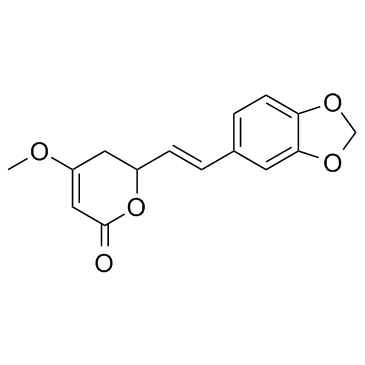| Description |
Methysticin is a major kavalactone in kava extract to induce CYP1A1.
|
| Related Catalog |
|
| Target |
CYP1A1
|
| In Vitro |
Methysticin triggers the most profound inducing effect on CYP1A1. Consistent with the experimental results, in silico molecular docking studies based on the aryl hydrocarbon receptor (AhR)-ligand binding domain homology model also reveals favorable binding to AhR for Methysticin compared with the remaining kavalactones. Additionally, results from a luciferase gene reporter assay suggested that kava extract, Methysticin is able to activate the AhR signaling pathway. Kava extract induces the expression of CYP1A1 via an AhR-dependent mechanism and that Methysticin contributes to CYP1A1 induction. The induction of CYP1A1 indicates a potential interaction between kava or kavalactones and CYP1A1-mediated chemical carcinogenesis. The MTS cell viability assay is used to determine the effects of kava extract and kavalactones on cell viability in mouse hepatic cells. Hepa1c1c7 cells are treated with various concentrations of kava extract (0-50 µg/mL) and six kavalactones (0-100 µM) for 24 h. The results indicate that kava extract at concentrations up to 50 µg/mL and kavalactones up to 100 µM do not induce cell death. For the following studies, kava extract at 0.78-6.25 µg/mL and kavalactones at 0.78-25 µM, concentrations that cause no damage to cells, are used[1].
|
| In Vivo |
The kavalactone Methysticin (6 mg/kg) is administered once a week for a period of 6 months to 6 month old transgenic APP/Psen1 mice by oral gavage. Methysticin treatment activates the Nrf2 pathway in the hippocampus and cortex of mice. The Aβ deposition in brains of Methysticin-treated APP/Psen1 mice is not altered compared to untreated mice. However, Methysticin treatment significantly reduces microgliosis, astrogliosis and secretion of the pro-inflammatory cytokines TNF-α and IL-17A. Methysticin treatment results in a significant activation of the Nrf2/ARE pathway in hippocampus and the cortex but not in the midbrain and cerebellum of ARE-luciferase reporter gene mice. Methysticin treatment significantly increases the expression of both genes compared to untreated animals[2].
|
| Cell Assay |
The mouse hepatoma cell line Hepa1c1c7 and AhR-deficient cell line CRL-2710 are grown in α-MEM supplemented with 10% FBS and antibiotics (50 U/mL Penicillin and 50 µg/mL Streptomycin) and maintained at 37°C in a humidified atmosphere with 5% CO2. The cytotoxicity of kava extract and kavalactones (e.g., Methysticin; 0.195313, 0.390625, 0.78125, 1.5625, 3.125, 6.25, 12.5, 25, 50, and 100 μM) is assessed using the tetrazolium reduction cell viability assay (MTS). After treatment for 24 h, the MTS assay is performed. The viability of the cells is calculated by comparing the absorbance of the treated cells with that of the DMSO controls[1].
|
| Animal Admin |
Mice[2] Treatment of transgenic APP/Psen1 mice (n=6) is started at an age of 25 weeks and lasted for 27 weeks. The animals are treated once a week with 6 mg/kg bodyweight Methysticin (0.15 mg/25 g mouse, corresponding to 100 µL of working solution). Control groups consist of wild type mice (n=6) and APP/Psen1 mice (n=6) which are vehicle-treated with an identical treatment regimen. At 52 weeks, the animals undergo behavioral testing and are euthanized afterwards. The brain hemispheres are separated to obtain both formalin-fixed tissue for paraffin embedding and tissue for biochemical analysis from the same animal. The left hemisphere is further dissected to separate the hippocampus from the remaining brain tissue. The fresh tissue is snap-frozen and immediately stored at -80°C. To induce Nrf2/ARE in the ARE-luciferase reporter gene mice, the mice receive 6 mg/kg bodyweight of Methysticin once. The mice's hippocampus, cortex, midbrain, and cerebellum are prepared and immediately snap-frozen in liquid nitrogen 6 h after Methysticin treatment[2].
|
| References |
[1]. Li Y, et al. Methysticin and 7,8-dihydromethysticin are two major kavalactones in kava extract to induce CYP1A1. Toxicol Sci. 2011 Dec;124(2):388-99. [2]. Fragoulis A, et al. Oral administration of Methysticin improves cognitive deficits in a mouse model of Alzheimer's disease. Redox Biol. 2017 Aug;12:843-853.
|


